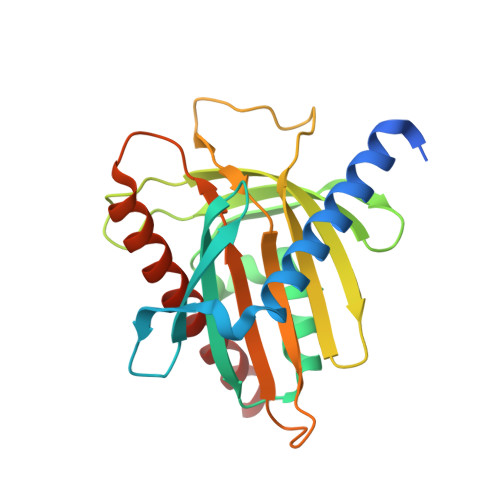Structure of the lutein-binding domain of human StARD3 at 1.74 angstrom resolution and model of a complex with lutein.
Horvath, M.P., George, E.W., Tran, Q.T., Baumgardner, K., Zharov, G., Lee, S., Sharifzadeh, H., Shihab, S., Mattinson, T., Li, B., Bernstein, P.S.(2016) Acta Crystallogr F Struct Biol Commun 72: 609-618
- PubMed: 27487925
- DOI: https://doi.org/10.1107/S2053230X16010694
- Primary Citation of Related Structures:
5I9J - PubMed Abstract:
A crystal structure of the lutein-binding domain of human StARD3 (StAR-related lipid-transfer protein 3; also known as MLN64) has been refined to 1.74 Å resolution. A previous structure of the same protein determined to 2.2 Å resolution highlighted homology with StARD1 and shared cholesterol-binding character. StARD3 has since been recognized as a carotenoid-binding protein in the primate retina, where its biochemical function of binding lutein with specificity appears to be well suited to recruit this photoprotective molecule. The current and previous structures correspond closely to each other (r.m.s.d. of 0.25 Å), especially in terms of the helix-grip fold constructed around a solvent-filled cavity. Regions of interest were defined with alternate conformations in the current higher-resolution structure, including Arg351 found within the cavity and Ω1, a loop of four residues found just outside the cavity entrance. Models of the complex with lutein generated by rigid-body docking indicate that one of the ionone rings must protrude outside the cavity, and this insight has implications for molecular interactions with transport proteins and enzymes that act on lutein. Interestingly, models with the ℇ-ionone ring characteristic of lutein pointing towards the bottom of the cavity were associated with fewer steric clashes, suggesting that steric complementarity and ligand asymmetry may play a role in discriminating lutein from the other ocular carotenoids zeaxanthin and meso-zeaxanthin, which only have β-ionone rings.
Organizational Affiliation:
Department of Biology, University of Utah, 257 S 1400 E, Salt Lake City, UT 84112, USA.

















